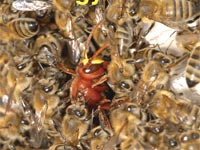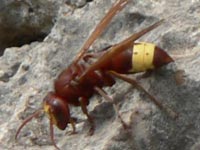When Oriental hornets attack, Cyprian honeybees mob them in a huge ball that targets the breathing apparatus in the hornet’s abdomen. The hornets can’t breathe without expanding their abdomens and with sheer numbers, the bees strangle the hornets to death.
 Hornets are giant wasps that pack a powerful sting. To most people, they can be a painful nuisance, but to honeybees, they’re killing machines. Hornets greatly outsize and overpower honeybees and a few individuals can decimate entire colonies.
Hornets are giant wasps that pack a powerful sting. To most people, they can be a painful nuisance, but to honeybees, they’re killing machines. Hornets greatly outsize and overpower honeybees and a few individuals can decimate entire colonies.
Asian honeybees have developed a remarkable defence called ‘heat-balling’ against their local hornet, Vespa velutina. A giant ball of bees piles onto the predator, weighing it down while vibrating their wing muscles. The frenetic activity greatly increases the temperature inside the ball to about 45C – hot enough to cook the hornet alive, but five degrees under the bees’ maximum tolerated temperature.
Cyprian honeybees face a different predator, the Oriental hornet Vespa orientalis and unlike its wimpier cousin V.velutina, this species can take the heat. The Oriental hornet lives in hot, dry climates ranging from Central Asia to the Mediterrenean and it tolerates temperatures just as high as honeybees.
Heat-balling shouldn’t work on them. And yet, Cyprian bees still encase Oriental hornets in large balls. Surprisingly, the strategy works – despite their heat tolerance, the hornets still die. The bees’ stings are useless against the hornet’s tough cuticle and they barely use them. What could they be doing instead?
How to strangle a hornet
 Alexandros Papachristoforou and colleagues from the Aristotle University of Thessaloniki noticed that when the bees mob the hornet, they go for its back end first. That seems like an unlikely spot for it’s where the powerful sting sits.
Alexandros Papachristoforou and colleagues from the Aristotle University of Thessaloniki noticed that when the bees mob the hornet, they go for its back end first. That seems like an unlikely spot for it’s where the powerful sting sits.
But it’s also the location of the hornets’ Achilles heel – it’s breathing apparatus. By mobbing its abdomen, the bees effectively strangle the hornet to death. (Have a look at this video of a this tactic at work – the hornet’s hapless head sticks out of a ball of bees).
The hornets’ entire abdomen is the equivalent of a human lung and they breathe by actively pumping air through small holes located there, called spiracles. They exhale by contracting muscles that pull the abdominal segments together, forcing air out through the spiracles. When these muscles relax, the segments spread out, the abdomen expands and air is sucked in.
When the abdomen is fully contracted, the spiracle is covered by a plate called a tergite. That stops the hornet from losing too much air, but it also gives the honeybees a window. Papchristoforou theorised that by piling onto the hornet, the bees prevented it from expanding its abdomen. The tergites prevent air from entering the spiracle and the hornet chokes.
Testing the theory
 When Papachristoforou covered these tergites manually, he found that the hornets’ respiration fell by 87%. To prove that this was what the bees were doing, he inserted plastic blocks under the tergites of some hornets (right), so they couldn’t properly cover the spiracles. Honeybees took twice as long to kill these hornets as individuals who hadn’t been similarly protected.
When Papachristoforou covered these tergites manually, he found that the hornets’ respiration fell by 87%. To prove that this was what the bees were doing, he inserted plastic blocks under the tergites of some hornets (right), so they couldn’t properly cover the spiracles. Honeybees took twice as long to kill these hornets as individuals who hadn’t been similarly protected.
The increased temperature inside the ball isn’t enough to finish the hornets off, but the researchers believe that it probably helps to speed things along. The extra heat increases the concentration of carbon dioxide in the hornet’s blood, anaesthetising it and making things easier for the surrounding bees.
Nonetheless, the Cyprian bees’ main strategy is to suffocate hornets rather than bake them. Papachristoforou has called this strategy ‘asphyxia-balling’ and it’s a fantastic example of an adaptive defence in the face of a super-predator.
More on bees and animal defences:
Is a virus responsible for the disappearing bees?
Genetic diversity gives honeybees an edge
Beetle and yeast vs. bee – how American bees are losing the evolutionary arms race
Ground squirrels use infrared signals to fool heat-seeking rattlesnakes
Aphids defend themselves with chemical bombs
Moths mimic each others’ sounds to fool hungry bats
Reference: Papachristoforou, Rortais, Zafeiridou, Theophilidis, Garnery, Thrasyvoulou & Arnold. 2007. Smothered to death: Hornets asphyxiated by honeybees. Curr Biol 17: R795-796
Images taken from Current Biology paper
Filed under: Animal behaviour, Animal kingdom, Insects & arthropods, Invertebrates, Predators and prey |











I have taken a picture of this happening in the south west of England. I have it online at http://outofdoubt.co.uk/photograph/2007/what-is-it/
I thought it was wasps but somebody left a comment to explain this phenomenon so now I’m reading this and putting a few links and explanation in my own post.
Thanks for the article.
[…] vicious stinging attacks against birds and other predators. Against wasps they turn to “heat-balling,” swarming over the attacker and then heating parts of their body up beyond 110 degrees […]
Hello!
Which particular frequency alerts the bees about such predators as hornets? Like for example, a kind of specific buzz or another vib tune that push the bees threat.
Thanks very much.
Manu
(BRAZIL)